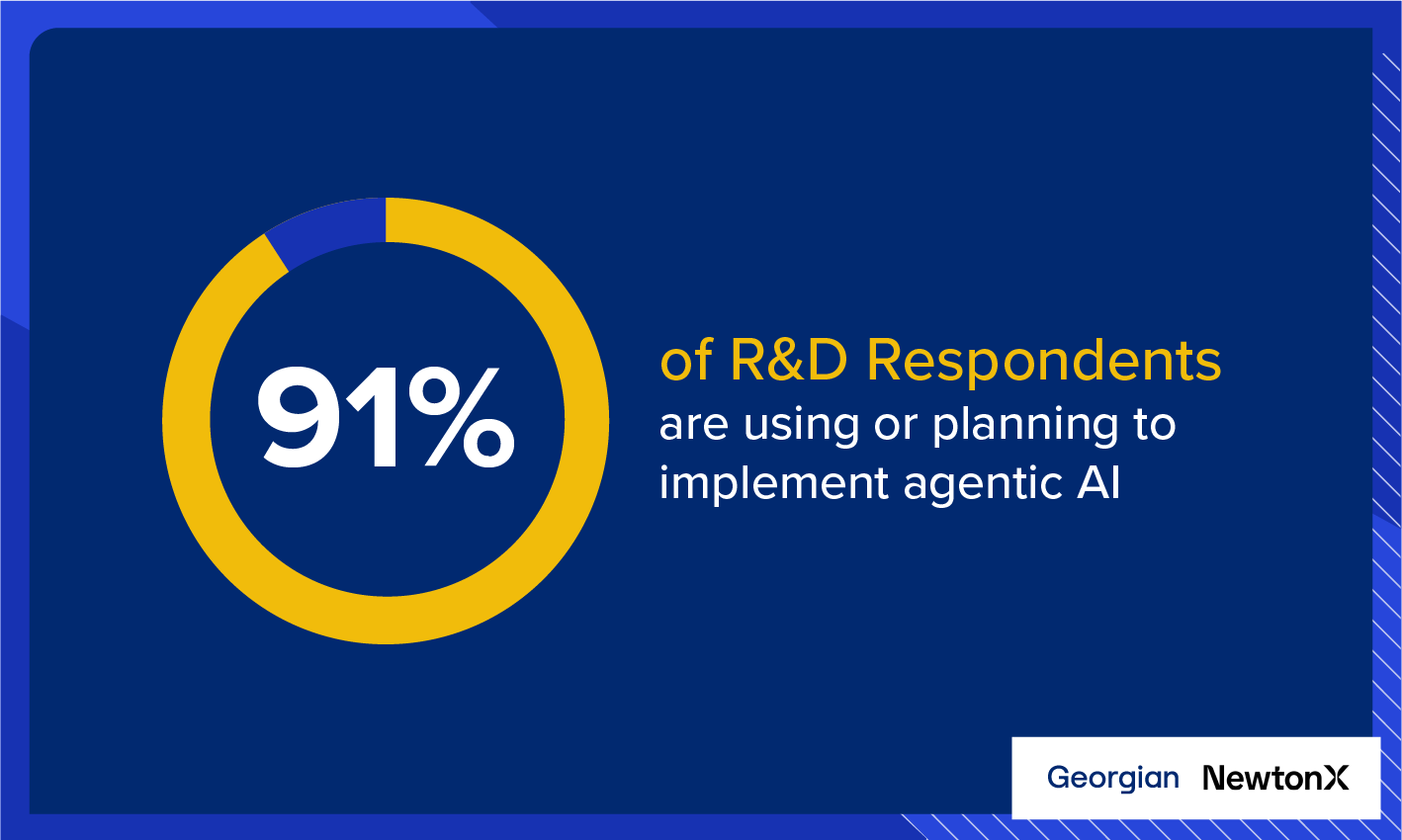
Agentic AI: Adoption insights from 600 executives
91% of R&D Respondents have implemented or are planning to implement agentic AI, with human-AI collaboration leading the way
New research from Georgian and NewtonX reveals early agentic AI adoption trends, human oversight requirements and reliability challenges. (Note that numbers below are approximate and rounded to the nearest whole number.)
Key Findings
- Widespread R&D adoption momentum: 91% of R&D Respondents have plans to adopt agentic AI, including 45% of R&D respondents already having some implementation in place.
- Strategic implementation approach: 48% of both R&D and go-to-market (GTM) Respondents are focusing on systems with human approval as they build confidence in the technology.
- Clear path to value: 55% of R&D Respondents expect high or transformational impact from agentic AI implementation. Among GTM Respondents, the figure is slightly lower, with 43% anticipating high or transformational impact.
- Marketing leading GTM adoption: Marketing content creation (43% actively using or piloting) and website/chatbot implementations (40% actively using or piloting) use cases are showing early momentum.
- Efficiency as the primary driver: 41% of GTM and 31% of R&D Respondents identify increased efficiency and workflow automation as the top benefit, creating ROI cases for implementation.
The Rise of Agentic AI
Agentic AI represents an evolution beyond generative AI, with capabilities to autonomously plan, reason about and execute complex tasks with minimal human intervention. Organizations across a range of industries are, according to our latest survey, recognizing the potential of this technology and taking steps to incorporate it into their operations.
In March 2025, Georgian, in partnership with research firm NewtonX, surveyed over 600 executives, including 400 growth-stage software executives and 200 enterprise executives. The study included 300 R&D Respondents and 300 GTM Respondents across 11 countries and 15 industries to provide a view of the current state of agentic AI adoption, implementation strategies and expected benefits.
For the purpose of this research, “agentic AI” was defined as software that is able to (a) interpret a task and any available context (data), (b) independently plan and reason about how to complete that task (and any identified sub-tasks) and then (c) complete the task with minimal human oversight.
Implementation Momentum Building
Our research reveals that organizations are making early progress in their agentic AI implementation journeys.
R&D Respondents (n=300) are showing early momentum, with 45% of the Respondents reporting their organizations are actively using agentic AI (14% report organization-wide implementation, 15% report individual use cases, with 17% piloting). Only 9% of the R&D Respondents indicated that they are not considering implementing agentic AI.
The GTM side (n=300) suggests similar momentum, with 36% of the GTM Respondents reporting they are actively implementing agentic AI (6% broadly across functions, 12% in limited use cases, and 17% piloting a use case), while 41% are in planning stages, demonstrating widespread recognition of the technology’s potential.
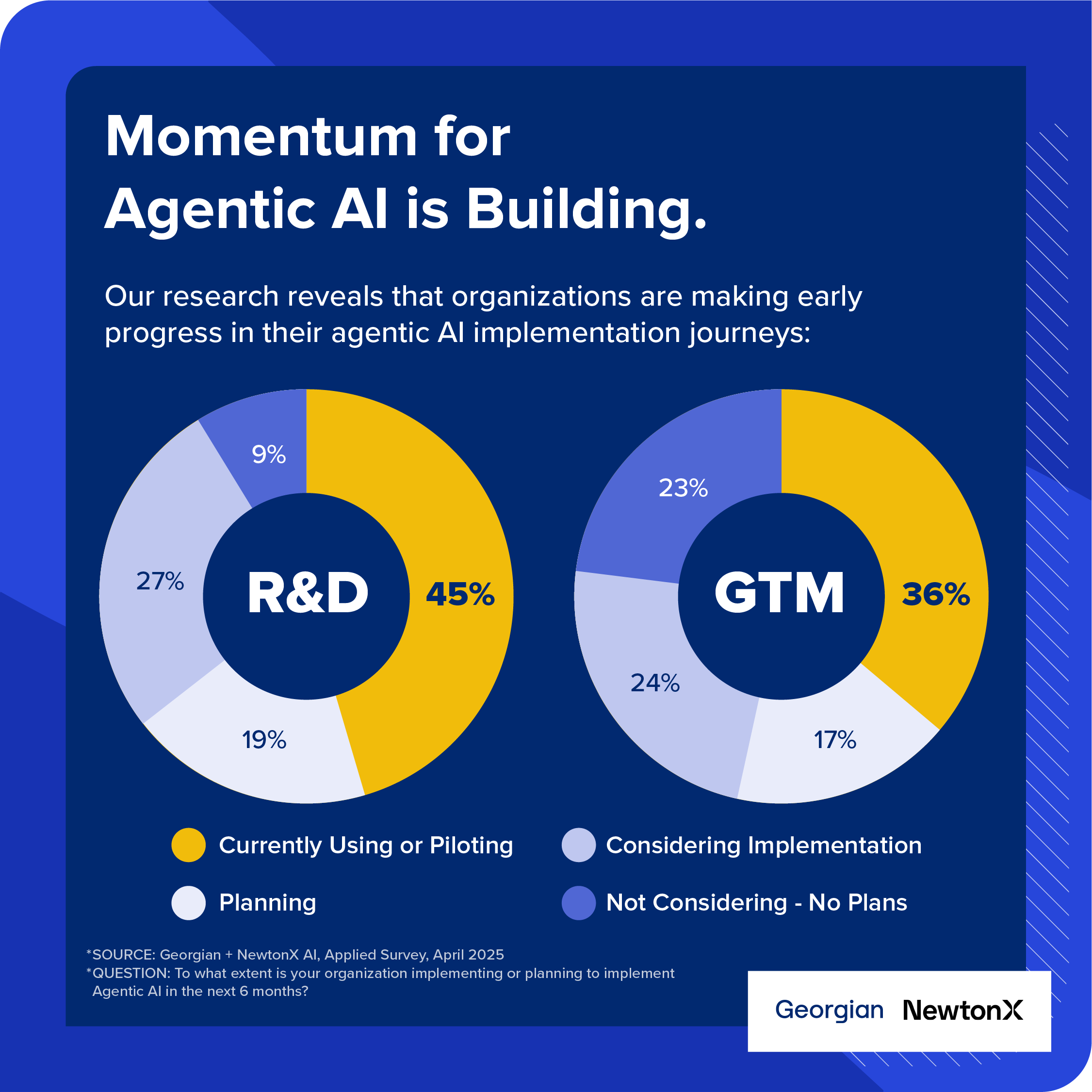
Moving Towards Reliability
When asked about scaling challenges and barriers to trusting agentic AI, one factor came back consistently highest across all Respondents: Reliability. Both R&D (32%) and GTM Respondents (31%) identify ensuring consistent performance across different use cases as an important focus area.
Organizations may have learned from their generative AI experiences and are now more aware of the benefits of establishing robust frameworks, appropriate guardrails and comprehensive testing protocols to ensure agentic AI delivers consistent results. Our recent report on the Agentic AI Landscape offers more detail on the reliability challenge with agentic AI.
Top Scaling Challenges
The top concerns for implementing agentic AI at scale for both R&D and GTM Respondents include:
- Reliability across use cases: 32% of R&D and 31% of GTM Respondents cited reliability as their top concern to scaling agentic AI
- High cost of scaling solutions: 19% for both R&D and GTM Respondents
- Data privacy and security: 15% of R&D and 18% of GTM Respondents
- Compliance and regulatory hurdles: 10% of R&D and 7% of GTM Respondents
- Lack of standardized frameworks and best practices: 8% of R&D and 7% of GTM Respondents
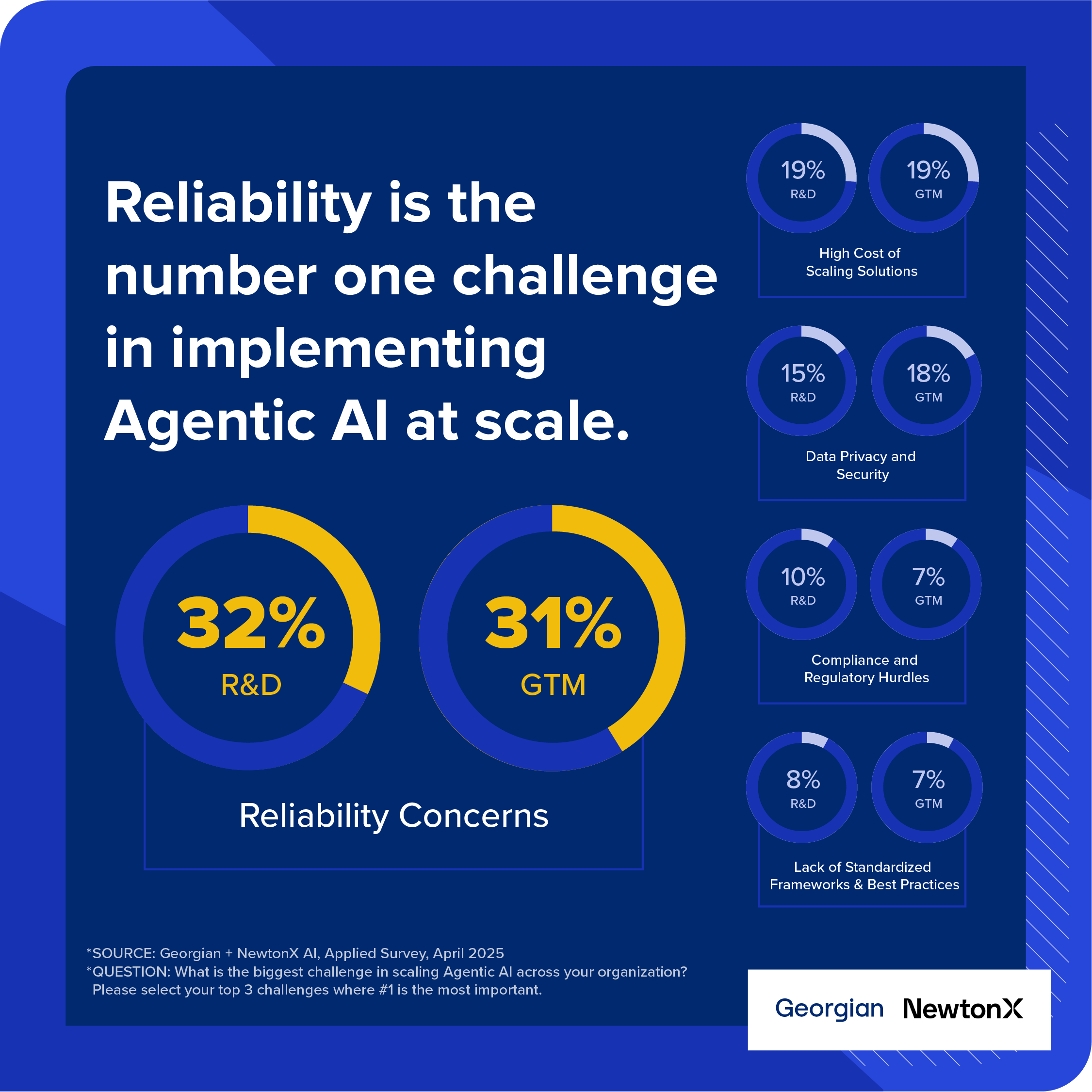
Top Barriers to Trusting Agentic AI
Examining barriers to trusting agentic AI, we see similar concerns selected by Respondents:
- Reliability concerns: 27% of R&D and 31% of GTM Respondents cited reliability as their #1 barrier to trusting Agentic AI (of 8 areas)
- Regulatory and compliance challenges: 23% of R&D respondents ranked regulatory and compliance challenges as their top trust issue versus only 13% of GTM Respondents.
- Lack of explainability/interpretability: 12% of R&D Respondents and 13% of GTM Respondents ranked a lack of explainability/interpretability as their top trust issue
- Data privacy issues: 11% of R&D and 12% of GTM Respondents ranked data privacy issues as their top concern
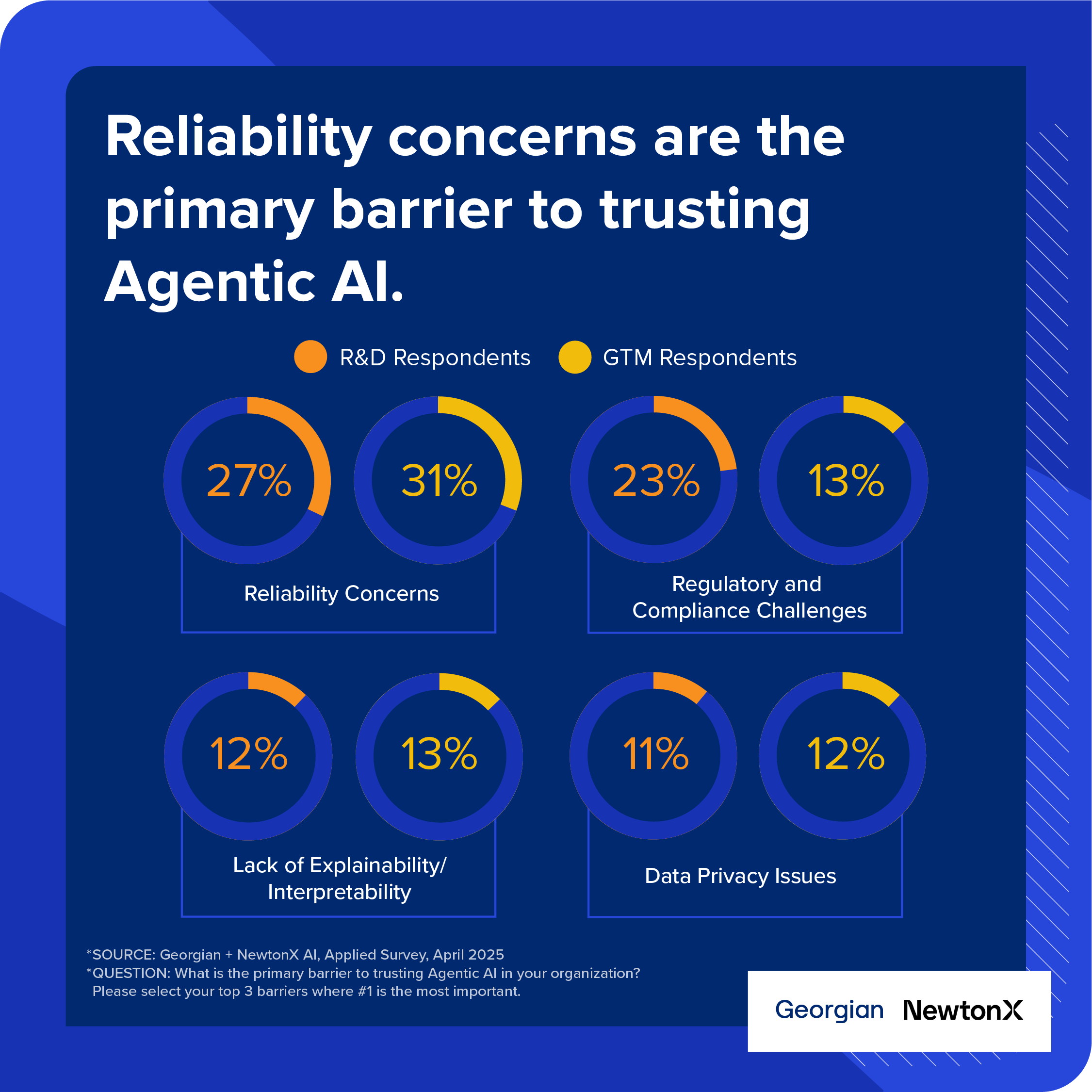
In our view, these findings suggest that while organizations recognize the potential of agentic AI, they are also mindful of the technical and operational challenges to be addressed for successful implementation of agentic AI.
The Human-AI Partnership — A Trusted Relationship So Far
Driven by reliability concerns, there is broad consensus among both R&D and GTM respondents for how respondents envision working with AI. When asked about their preferred level of AI autonomy, an identical 48% of both R&D and GTM Respondents appear to favor a system where “AI can make recommendations but requires human approval for execution.”
AI excels at processing large datasets and identifying patterns, while humans contribute judgment and context. Notably, concerns about job displacement ranked lowest among the barriers to trusting agentic AI, with only 1% of R&D and 3% of GTM leaders viewing it as a significant issue. To us, this data suggests some recognition of AI’s potential to enhance productivity and efficiency.
The data implies that organizations are focusing on augmenting human capabilities rather than replacing them and creating enhanced productivity while maintaining appropriate human oversight. See our recent Agentic AI report for more on Georgian’s view on how humans may work together with agentic AI.
R&D and GTM Alignment
Despite existing challenges and barriers, both groups express optimism about the impact of agentic AI, with both groups most likely to expect a high or transformational impact from agentic AI.
- 55% of R&D respondents expect a high or transformational impact from agentic AI.
- 43% of GTM respondents expect a high or transformational impact from agentic AI.
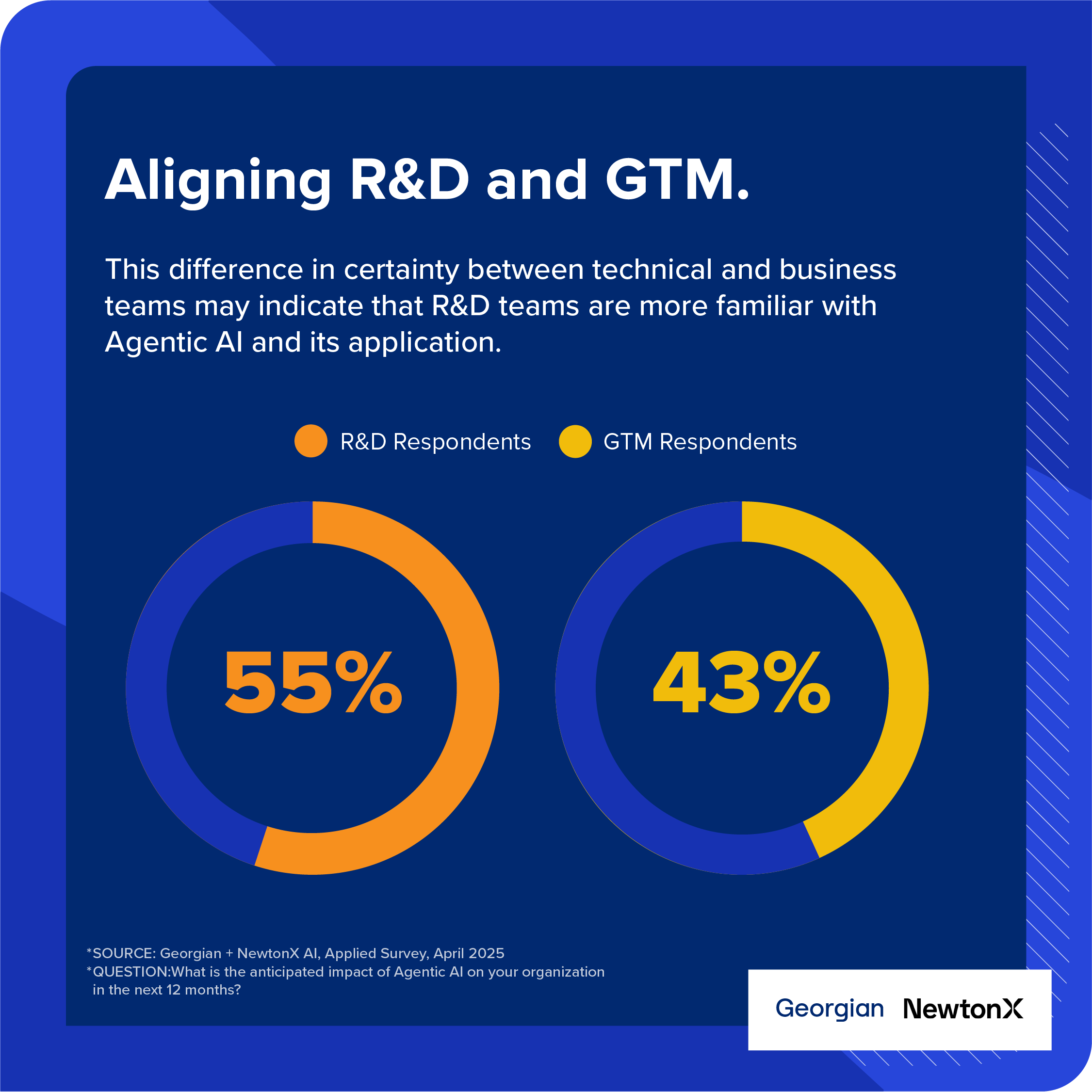
R&D respondents appear to exhibit greater certainty of the impact of agentic AI, with only 4% uncertain about the impact of agentic AI compared to 23% of GTM respondents. This data suggests that R&D teams may have a deeper understanding of agentic AI and its applications.
Expected Benefits: Efficiency Leads the Way
When asked about the primary benefits of agentic AI implementation, both groups emphasized operational efficiency:
- 31% of R&D and 41% of GTM Respondents ranked efficiency and workflow automation as their top expected benefit.
- R&D respondents also highlighted cost reduction (26% vs. 16% for GTM).
- Improved customer experience was a priority for both groups (16% R&D, 17% GTM).
- New revenue streams (16% R&D and 15% GTM) and enhanced decision-making capabilities (11% for both R&D and GTM) round out the top five expected benefits

Efficiency leads the way
These anticipated benefits present compelling business cases for agentic AI adoption and are likely driving its rapid implementation. However, the focus on efficiency and cost reduction suggests that many companies are still in the early stages of agentic AI adoption.
To better understand AI maturity, Georgian and NewtonX segmented respondents using a four-stage model: Crawl (low AI maturity), Walk, Jog, and Run (high AI maturity). According to this model:
- Companies focusing on efficiency and cost reduction are typically in the Crawl or Walk stages.
- As organizations mature, they are expected to progress to the Jog and Run stages, where they prioritize advanced agentic AI applications such as new revenue streams and enhanced decision-making capabilities.
Notably, companies already at the Run level are leveraging agentic AI for these advanced use cases, demonstrating its potential to drive transformative outcomes.
Note: The crawl, walk, run model was initially created by Georgian in 2023 to track generative AI adoption and expanded upon in Georgian’s AI, Applied Report in November 2024.
Looking Ahead
This survey provides an initial glimpse into adoption trends. For a more in-depth analysis of agentic AI technology, implementation strategies, and market evolution, check out our complete AI Landscape Series: Agentic Platforms and Applications report.
Stay tuned for additional insights from the Georgian x NewtonX survey, set to release in May 2025, which will offer further benchmarks on AI adoption patterns, use cases, barriers, and company AI maturity, or take a look at the data from the first wave here.
Methodology
This research was conducted by Georgian in partnership with research firm NewtonX. The survey included responses from over 600 executives, including 400 growth-stage software executives and 200 enterprise executives. The study included 300 R&D Respondents and 300 go-to-market Respondents across industries.
Read more like this
From Static to Adaptive: Scaling AI Reasoning Without the Waste
2025 has been the year of reasoning models. OpenAI released o1 and...
Why Georgian Invested in Replit
We are excited to announce our latest investment in Replit’s $250 million…
A Practical Guide to Reducing Latency and Costs in Agentic AI Applications
Scaling companies that are actively integrating Large Language Models (LLMs) into their…